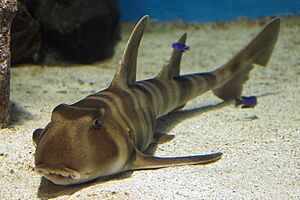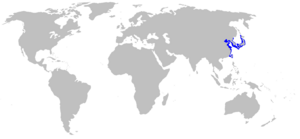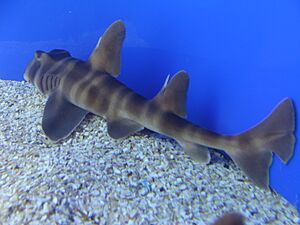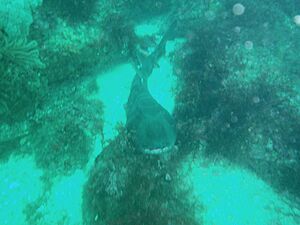Japanese bullhead shark facts for kids
Quick facts for kids Japanese bullhead shark |
|
|---|---|
 |
|
| Conservation status | |
| Scientific classification | |
| Genus: |
Heterodontus
|
| Species: |
japonicus
|
 |
|
| Range of the Japanese bullhead shark | |
| Synonyms | |
|
Cestracion japonicus Maclay & Macleay, 1884 |
|
The Japanese bullhead shark (Heterodontus japonicus) is a unique type of shark found in the northwestern Pacific Ocean. You can find it off the coasts of Japan, Korea, and China. This shark lives on the ocean floor, usually in rocky areas or kelp beds, at depths of about 6 to 37 meters (20 to 120 feet).
It can grow up to 1.2 meters (4 feet) long. You can spot it by its short, blunt head, two tall fins on its back with spines, and brown stripes on its body. The Japanese bullhead shark is a calm, slow swimmer. It mainly eats creatures with shells and small bony fishes. Females lay special spiral-shaped eggs, often in shared "nests." People don't usually fish for them much.
Contents
Discovering the Japanese Bullhead Shark
Scientists Nicholas Miklouho-Maclay and William John Macleay first described this shark in 1884. They gave it the scientific name Cestracion japonicus. The first shark they studied was a female caught near Tokyo.
This shark is also known by other names. These include bull head, cat shark, Japanese horn shark, and Cestracion shark. Sometimes it's even called a Port Jackson shark, but that usually refers to a different shark species.
What Does the Japanese Bullhead Shark Look Like?
The Japanese bullhead shark is a medium-sized shark. It can reach a maximum length of about 1.2 meters (4 feet). Its body is shaped like a cylinder. It has a short, wide head and a blunt snout, which looks a bit like a pig's nose. This is typical for bullhead sharks.
Its eyes don't have a special eyelid that some sharks have. Behind its eyes are tiny holes called spiracles. These help the shark breathe. There are small ridges above its eyes. Its nostrils are split into two openings. Long skin flaps reach from the nostrils to its mouth.
The shark's mouth is small and almost at the tip of its snout. Its front teeth are small and sharp. The back teeth are wide and round, perfect for crushing shells. There are deep grooves at the corners of its mouth.
Fins and Skin
The first fin on its back is very large and tall. It starts above its pectoral fins, which are its side fins. The second back fin is smaller but similar in shape. Both back fins have strong spines on their front edges. Its pelvic fins, located near its belly, are much smaller than the first back fin.
The fin near its tail, called the anal fin, is well in front of the tail fin. The tail fin is wide. It has a short bottom part and a long top part with a notch near the tip. The shark's skin feels rough. This is because of its large, tough scales called dermal denticles.
Color and Pattern
The Japanese bullhead shark is light brown. It has 11 to 14 wide, dark bands and thinner stripes from its snout to its tail. These bands have soft, blurry edges. There's also a faint lighter band on top of its head between its eyes. A darker spot is found under each eye.
Where Do Japanese Bullhead Sharks Live?
The Japanese bullhead shark lives in the waters from Japan to the Korean Peninsula. Its range also goes south along the coast of China to Taiwan. It is a bottom-dwelling shark. It prefers areas with rocks, rocky reefs, or kelp. It lives at depths of about 6 to 37 meters (20 to 120 feet).
Life and Habits of the Japanese Bullhead Shark
The Japanese bullhead shark is a slow-moving predator. It hunts for food by "walking" along the sea bottom. It uses its pectoral and pelvic fins in an alternating motion to move. It eats crustaceans like crabs, molluscs like clams, small fishes, and sea urchins. When it finds prey, it grabs it with its mouth. Then it grinds the food into pieces using its strong, molar-like back teeth.
Reproduction and Life Cycle
Like other sharks in its family, the Japanese bullhead shark lays eggs. Females produce large egg cases. These cases are often called "mermaid's purses." They have thin ridges that spiral three times around the outside. They also have a pair of short tendrils at the tip.
The females lay their eggs at a depth of about 8 to 9 meters (26 to 30 feet). They place them within beds of rock or kelp. Sometimes, several females will lay their eggs together in one "nest." A single nest might have up to 15 eggs in total. However, the females leave the site after laying their eggs.
In Japanese waters, females lay pairs of eggs 6 to 12 times. This happens between March and September. The most active egg-laying time is in March and April. The eggs take about a year to hatch. When they hatch, the baby sharks are about 18 cm (7 inches) long. Young sharks have taller back fins. Their color pattern is similar to adults but brighter. Male sharks become old enough to reproduce when they are about 69 cm (27 inches) long.
Japanese Bullhead Sharks and Humans
The Japanese bullhead shark is harmless to humans. Divers can even catch them by hand. This shark is not a major target for fishing. It is sometimes caught for food in Japan and possibly other places. You can also see these sharks in Japanese public aquariums.
Scientists have not yet fully studied the conservation status of this species. This means we don't know if it's endangered or not. However, it seems to have disappeared from some areas, like the Bohai Sea. This might be due to climate change.




